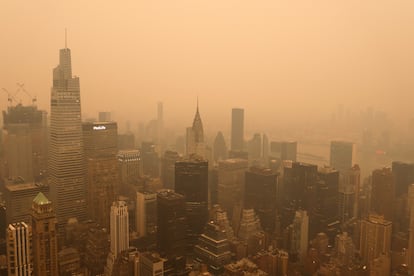More than 150 million people are breathing polluted air in the US
Los Angeles is the city with the worst ozone pollution in the country, while Bakersfield is the metropolitan area most affected by particulate matter

Nearly half of the U.S. population lives with unhealthy levels of air pollution, according to The American Lung Association’s State of the Air 2025 report. This study finds that 46% of Americans—156.1 million people—are living in places that get failing grades for unhealthy levels of ozone or particle pollution, two of the most widespread and dangerous air pollutants. “This is nearly 25 million more people breathing unhealthy air compared to last year’s report, and more than in any other State of the Air report in the last ten years,” the report says. Extreme heat, drought, and wildfires are among the main causes of the problem.
The research places the worst air quality problems in the Western states, but the geographic distribution of air pollution has begun to shift toward the East Coast. Bakersfield, California tops the list for worst short-term particle pollution for the third straight year, and for year-round particulate matter for the sixth consecutive year. Los Angeles remains the city with the worst ozone pollution in the country, as it has been for 25 of the 26 years the report has been compiled, although Angelenos now experience 77 fewer days of harmful ozone levels each year. Over the past 12 months, Cleveland, Ohio, recorded the most dramatic change of all American cities, moving from the 54th to the ninth most polluted city.
The burden of living with polluted air is also not distributed equally across the entire population. African Americans are the group most exposed to poor air quality and most likely to suffer from one or more chronic diseases that make them more vulnerable to air pollution, such as asthma, diabetes and heart disease. Hispanics are also nearly three times more likely than whites to live in an area with poor air quality ratings.
125 million people breathing high levels of ozone
Ozone air pollution affects Americans the most, including the most vulnerable population: millions of infants and children, along with people 65 and older. Between 2021 and 2023, 37% of the population (about 125.2 million people) was exposed to ozone levels that put their health at risk, an increase of 24.6 million people compared to last year.
The Clean Air Act of 1970 (amended 35 years ago) brought decades of successful reductions in ozone pollution, but the rollback of this achievement is more troubling than ever. This year’s report reveals that 211 counties, spread across 35 states and the District of Columbia, received an F rating for their ozone levels (the worst of all).
California has the metropolitan areas with the worst air quality
California remains the state with the most metropolitan areas on the list, with nine of the 25 most polluted cities in the country. Arizona, Colorado, Nevada, New Mexico, Oklahoma, Texas, and Utah complete the list. Four more cities join the list this year: Chicago, New York, St. Louis, and Sheboygan.
In 2021, 2022, and 2023, 77.2 million people lived in counties that received an F rating for harmful spikes in particle pollution. This represents an increase of 12.1 million people since the last report and the seventh consecutive year of rising health threats from this deadly pollutant.
Populations at Risk
More than 265 million people live in the 885 counties with sufficient monitoring data to be assigned a rating for at least one pollutant in the 2025 report. Most U.S. counties lack monitors, meaning many communities, especially rural ones, lack air quality data. However, the research concludes that 156 million residents are at risk of health problems. Some groups of people are especially vulnerable to illness and death from air pollution.
In this regard, approximately 26 million African Americans and 15.2 million Hispanics live in counties that received failing grades on all three measures (ozone pollution, short-term particulate matter, and daily and annual particulate matter).
Sign up for our weekly newsletter to get more English-language news coverage from EL PAÍS USA Edition
Tu suscripción se está usando en otro dispositivo
¿Quieres añadir otro usuario a tu suscripción?
Si continúas leyendo en este dispositivo, no se podrá leer en el otro.
FlechaTu suscripción se está usando en otro dispositivo y solo puedes acceder a EL PAÍS desde un dispositivo a la vez.
Si quieres compartir tu cuenta, cambia tu suscripción a la modalidad Premium, así podrás añadir otro usuario. Cada uno accederá con su propia cuenta de email, lo que os permitirá personalizar vuestra experiencia en EL PAÍS.
¿Tienes una suscripción de empresa? Accede aquí para contratar más cuentas.
En el caso de no saber quién está usando tu cuenta, te recomendamos cambiar tu contraseña aquí.
Si decides continuar compartiendo tu cuenta, este mensaje se mostrará en tu dispositivo y en el de la otra persona que está usando tu cuenta de forma indefinida, afectando a tu experiencia de lectura. Puedes consultar aquí los términos y condiciones de la suscripción digital.
More information
Archived In
Últimas noticias
Families demand repatriation of bodies of Colombians who died in Ukraine: ‘This war is a slaughterhouse for foreigners’
James Cameron: ‘For the films I like to make to continue to exist, we have to find a way to make them cheaper’
Helen Levitt, the photographer who captured the theater of the everyday
The guardians of the meteorites of the Argentine Chaco
Most viewed
- Christian Louboutin: ‘Young people don’t want to be like their parents. And if their parents wear sneakers, they’re going to look for something else’
- US sanctions against jailed cartel leader ‘El Marro’ highlight Mexico’s lack of control over its prisons
- Cartels in Mexico take a leap forward with narco-drones: ‘It is criminal groups that are leading the innovation race’
- Liset Menéndez de la Prida, neuroscientist: ‘It’s not normal to constantly seek pleasure; it’s important to be bored, to be calm’
- ‘El Limones’ and the growing union disguise of Mexican organized crime











































